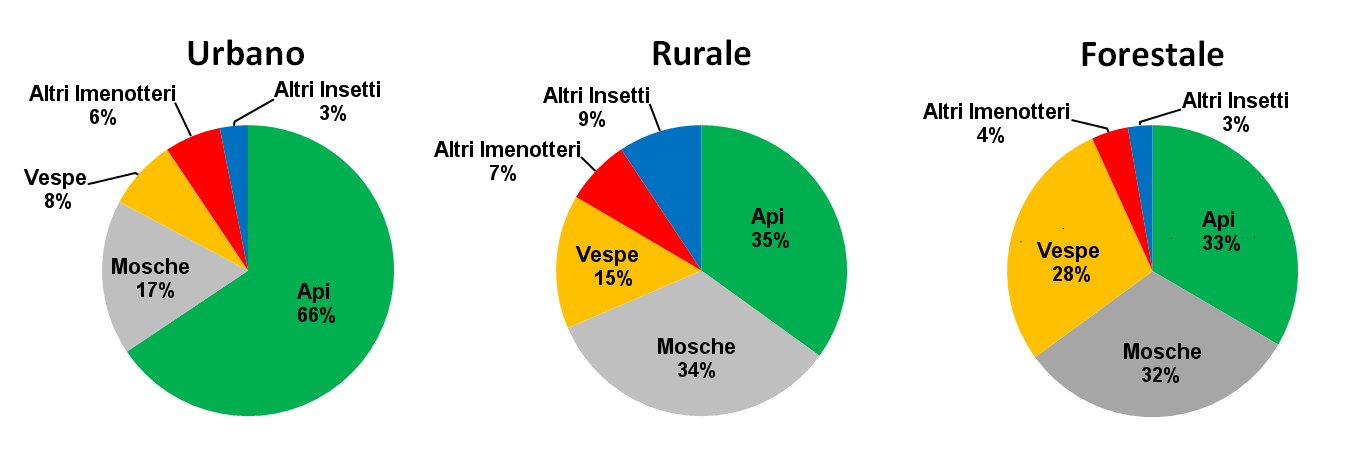The Yellow-legged hornet is the first species of Vespa accidentally introduced into Europe from Asia.Vespa velutina causes multiple threats, however the extent of the impacts produced has not yet been quantified and documented appropriately. Despite this lack, it is possible to assess the components and/or the activities which are affected or may be impacted by Vespa velutina and for which it is necessary to perform more studies in the future, in order to confirm and estimate the amount of threats.
From the analysis of the research conducted so far in Europe it is possible to estimate the negative impacts that the species may create:
1. Economic threats: decreasing of beekeeping productions; cost for the control activities and nest removal;
2. Ecological threats: impacts on biodiversity; impacts on pollination activity; competition with native species;
3. Public health threats: potential danger for citizens.
Impact on apiaries
Vespa velutina preys on other species of insects, and especially honeybees. The adults feed on sugary substances, however, they prey on other insects to provide proteins necessary for the development of the broods. In autumn the colonial nests reach large sizes and in a year each nest may develop potentially more than 10,000 individuals (up to 13,000, an average of 6,000). This biomass requires a great amount of protein substances.
The apiaries are a very attractive source for Vespa velutina,because there is a high concentration of honeybees. Studies performed in France have demonstrated that in urbanized environments, where the concentration of apiaries is high, the diet of Vespa velutina is composed for almost 70% of honey bees and other similar species (Apoidea).
The French research group of Monceau and colleagues monitored the predation of Vespa velutina on apiaries. In an apiary with six beehives, in the sampling period they caught a total of 360 workers, and most of these visited daily the apiary. This indicates that once the species has identified an important protein source such as an apiary, it visits the site every day, probably because of a greater success of predation. Of the six beehives monitored in the season, one was completely destroyed, while in the other five ones the size of the colonies halved. In addition, five Vespa velutina nests were discovered within 1 km from the experimental apiary; so it is possible that apiaries were attacked by individuals from different colonies.
Impact on ecosystems
The predatory activity of the Yellow-legged hornet might have an adverse impact on insect communities, reducing local biodiversity. In fact, besides domesticated honeybees, Vespa velutina preys on other Hymenoptera, including different species of wild bees and other Vespidae (wasps in general), but also Diptera (flies and mosquitoes) and other insects. Species preyed upon by Vespa velutina and their proportion varies according to the prey availability in the environment. A French study showed that in an urban environment, Vespa velutinaprays almost honey bees and other Apoidea (66% of the diet), while in a woodland environment bees and other Apoidea drop to 33% and Diptera increase to 32%.

Many of the species preyed upon by Vespa velutina play a role in pollinating plants, so a reduction in their numbers may cause damage even at the ecosystem level. The predation pressure known in apiaries since the month of July may have similar effects also on other pollinating insects, creating a decline in pollination effectiveness.
Impact on public health
Nests of Vespa velutina may contain thousands of hornets and are often built in urban areas, e.g. on trees near houses or on artificial supports (balconies, eaves, etc.). The species could be very dangerous in the case of repeated stings or when the people involved are allergic to its venom, which can lead to serious symptoms, and, at worst, to an anaphylactic shock.